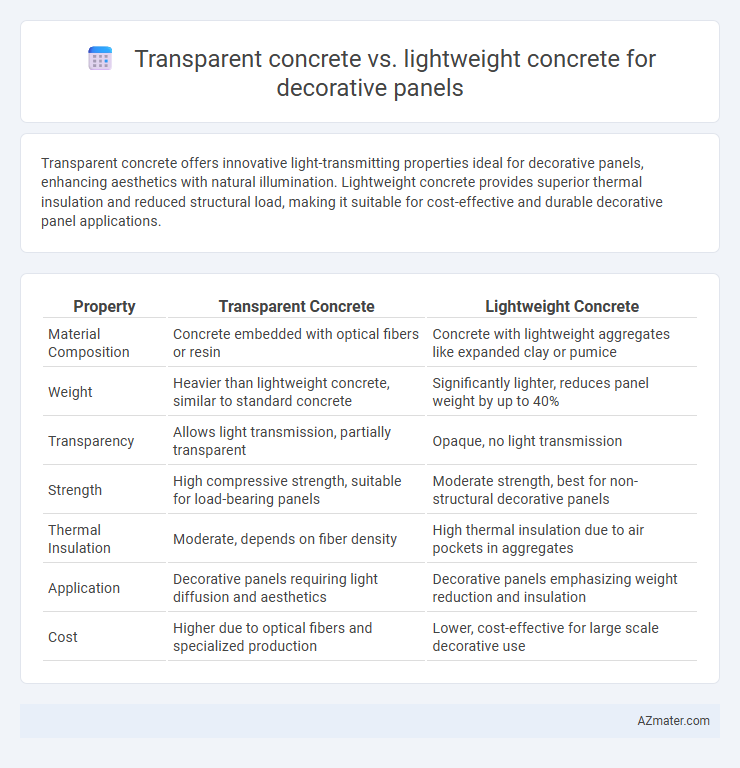Transparent concrete offers innovative light-transmitting properties ideal for decorative panels, enhancing aesthetics with natural illumination. Lightweight concrete provides superior thermal insulation and reduced structural load, making it suitable for cost-effective and durable decorative panel applications.
Table of Comparison
| Property | Transparent Concrete | Lightweight Concrete |
|---|---|---|
| Material Composition | Concrete embedded with optical fibers or resin | Concrete with lightweight aggregates like expanded clay or pumice |
| Weight | Heavier than lightweight concrete, similar to standard concrete | Significantly lighter, reduces panel weight by up to 40% |
| Transparency | Allows light transmission, partially transparent | Opaque, no light transmission |
| Strength | High compressive strength, suitable for load-bearing panels | Moderate strength, best for non-structural decorative panels |
| Thermal Insulation | Moderate, depends on fiber density | High thermal insulation due to air pockets in aggregates |
| Application | Decorative panels requiring light diffusion and aesthetics | Decorative panels emphasizing weight reduction and insulation |
| Cost | Higher due to optical fibers and specialized production | Lower, cost-effective for large scale decorative use |
Introduction to Decorative Concrete Panels
Decorative concrete panels enhance architectural aesthetics by combining functionality with design innovation. Transparent concrete panels incorporate optical fibers, allowing light transmission while maintaining structural strength, ideal for dynamic interior lighting effects. Lightweight concrete panels, composed of porous aggregates, offer ease of installation and thermal insulation, making them suitable for diverse decorative applications.
What is Transparent Concrete?
Transparent concrete, also known as light-transmitting concrete, incorporates optical fibers or resin-based light-transmitting elements into a cementitious matrix, allowing natural or artificial light to pass through the material. This innovative concrete is used in decorative panels to create visually striking effects by illuminating interior spaces while maintaining structural integrity. In contrast to lightweight concrete, which prioritizes reduced density and insulation, transparent concrete emphasizes aesthetic appeal and light permeability for architectural applications.
What is Lightweight Concrete?
Lightweight concrete is a type of concrete that incorporates lightweight aggregates such as expanded clay, shale, or pumice, resulting in reduced density and improved thermal insulation properties compared to traditional concrete. It is often chosen for decorative panels due to its ease of handling, enhanced fire resistance, and ability to achieve intricate shapes without excessive weight. Unlike transparent concrete, which integrates optical fibers for light transmission, lightweight concrete prioritizes weight reduction and insulation performance, making it ideal for energy-efficient architectural applications.
Key Material Properties Comparison
Transparent concrete features embedded optical fibers or resin-based materials allowing light transmission, offering enhanced aesthetic appeal and natural illumination in decorative panels. Lightweight concrete utilizes aggregates such as expanded clay or pumice, resulting in reduced density and improved thermal insulation, beneficial for ease of installation and energy efficiency. Both materials differ significantly in compressive strength and durability, with lightweight concrete generally providing higher structural performance, while transparent concrete prioritizes visual effect over load-bearing capacity.
Aesthetic Appeal: Transparency vs. Texture
Transparent concrete offers a unique aesthetic appeal by allowing light to pass through, creating glowing decorative panels with dynamic visual effects that enhance modern architectural designs. Lightweight concrete, in contrast, emphasizes texture and surface variation, providing a tactile and visually rich finish ideal for adding depth and rustic charm to facades. Choosing between transparency and texture depends on whether the design prioritizes luminous openness or structured visual complexity.
Installation and Handling Techniques
Transparent concrete installation requires specialized handling to avoid surface damage, involving careful alignment of optical fibers or embedded light-transmitting elements within the panel matrix. Lightweight concrete decorative panels demand precise mixing and curing processes to maintain structural integrity while ensuring ease of transport and installation due to their reduced density. Both materials benefit from pre-fabricated panel systems that streamline on-site assembly, minimizing labor costs and installation time.
Structural Performance and Durability
Transparent concrete offers superior structural performance due to embedded optical fibers that maintain load-bearing capacity while allowing light transmission, making it ideal for decorative panels where aesthetics and strength are critical. Lightweight concrete provides excellent durability through reduced density and improved thermal insulation, but it often sacrifices some compressive strength compared to traditional concrete materials. For decorative panels, transparent concrete ensures enhanced structural integrity and unique visual appeal, whereas lightweight concrete emphasizes durability and ease of installation in less structurally demanding applications.
Energy Efficiency and Light Transmission
Transparent concrete enhances energy efficiency by allowing natural light to penetrate interior spaces, reducing the need for artificial lighting and lowering electricity consumption in decorative panel applications. Lightweight concrete offers superior thermal insulation due to its low density and air-filled pores, improving energy conservation by minimizing heat transfer through panels. While transparent concrete optimizes light transmission up to 15%, lightweight concrete typically provides better thermal resistance with an R-value significantly higher, making each suited for specific energy-saving and aesthetic needs in architectural designs.
Cost Implications and Market Availability
Transparent concrete, often incorporating optical fibers, tends to have higher cost implications due to specialized materials and manufacturing processes, limiting its widespread market availability compared to lightweight concrete. Lightweight concrete offers a cost-effective solution for decorative panels, benefiting from abundant raw materials and established production techniques, resulting in broader market access and versatility. The choice between these materials depends on budget constraints and aesthetic priorities, with transparent concrete favored for premium, innovative designs and lightweight concrete for economical, easily sourced applications.
Best Applications in Modern Architecture
Transparent concrete, embedded with optical fibers, is ideal for modern architectural applications requiring innovative light-transmitting decorative panels that enhance natural lighting while maintaining structural strength. Lightweight concrete offers superior thermal insulation and reduced load, making it suitable for large-scale exterior or interior decorative panels where energy efficiency and ease of installation are priorities. Combining transparent concrete for aesthetic illumination and lightweight concrete for insulation addresses diverse design needs in contemporary building facades and interior partitions.

Infographic: Transparent concrete vs Lightweight concrete for Decorative panel
 azmater.com
azmater.com